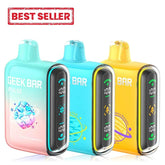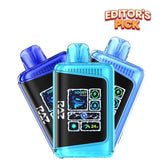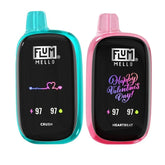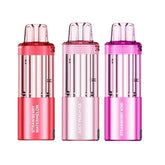Does Vaping Affect Your Skin? A Thorough Guide Offered
Have you ever found yourself marveling at the swirling vapor clouds from your vape, only to wonder, "What's this doing to my skin?" You're certainly not alone. As vaping takes the spotlight as the cooler, supposedly less harmful sibling of smoking, many of us are left wondering about the silent toll it takes on our skin.
In this blog, we're peeling back the misty veil to expose the hidden effects of vaping on your skin. From the deceptive charm of nicotine to the myriad chemicals lurking in your vape juice. Should you quit vaping to sidestep these effects, or are there ways to mitigate the damage and improve your skin's condition? Scroll the text and be ready to clear the air now.
Quick Look:
- Understanding Vaping
- The Impact of Vaping on Skin Health
- 13 Skin Care Tips for Minimizing Vaping Side Effects
- Other Vaping Side Effects
- How to Avoid Vaping Side Effects?
- Are There Any Health Benefits to Vaping?
- Is Vaping Better for Skin than Smoking?
- Frequently Asked Questions Section
Understanding Vaping
Vaping is the act of inhaling and exhaling vapor produced by an electronic cigarette (e-cig). In contrast, it might seem like a safer choice compared to smoking.
Various vape devices like the most popular disposable vapes, reusable and refillable pod systems, and mod kits should pair with e-liquid. The e-juice generally contains substances like nicotine, propylene glycol, vegetable glycerin, abstracted flavorings, and water. When you vape, you're exposing your skin to these substances:

Nicotine: This is the stuff that makes vaping addictive, especially for ex-smokers who need high nicotine content to fight their cravings. It can be made in the lab or extracted from tobacco leaves. Different from traditional cigarettes, vape juices are available in levels of nicotine strength from 0mg to 50mg, even denser by DIY e-juice.
Propylene Glycol: These are ingredients in the vape juice that make the mist. PG is a clear, colorless liquid that is commonly used as a base in e-liquids. It's known for providing a "throat hit," which mimics the sensation of smoking tobacco. PG is also a carrier for flavorings; it helps to distribute taste evenly throughout the vape juice. It's thinner than vegetable glycerin, making it less likely to cause build-up in the vaping device.
Vegetable Glycerin (VG): VG is a thicker, sweeter liquid compared to PG. It's used in e-liquids to produce denser vapor clouds. VG is known for its smoothness, which can reduce the throat hit when inhaled. E-liquids with a higher VG content are popular among users who enjoy doing vape tricks or those looking for a milder throat sensation.
Flavorings: Flavorings are what make vaping a diverse and customizable experience. E-liquids come in a vast array of flavors, from traditional tobacco and menthol to fruit, dessert, beverage, and exotic combinations. These flavorings are typically food-grade and are used to create a pleasant taste and aroma when vaping.
Water: Small amounts of distilled water might be added to e-liquid to adjust the viscosity or enhance certain flavors. Alcohol can also contribute to the throat hit.
Battery and Heating Coil: The battery supplies power (measured in watts) to the heating coil. When activated, the electrical current flows from the battery to the coil, causing it to heat up. The heat then vaporizes the e-liquid soaked into the wicking material around the coil, creating vapor.
The Impact of Vaping on Skin Health

Dehydration and Dryness
Nicotine has diuretic properties, which means it can increase the frequency of urination, leading to dehydration. When the body is dehydrated, it affects the skin, making it appear more dry and flaky. This dehydration accentuates fine lines and wrinkles, making them more pronounced, and can give the skin a rough, uneven texture.
Blood Flow, Nutrition, and Skin Health
Vaping, especially due to nicotine, makes your blood vessels smaller, which means less blood gets to your skin. Blood carries oxygen and good stuff like vitamins to your skin to keep it healthy. When there's less blood flow, your skin might not look as lively and can get damaged more easily. Think of it like a plant not getting enough water; it starts to wilt.
Dryness, Irritation, and Skin Barrier
The stuff in vape juice, like propylene glycol and vegetable glycerin, can pull moisture out of your skin. This can make your skin dry and itchy, like how your lips feel chapped when they're dry. This dryness can also mess with your skin's natural protective layer, making it easier for bad stuff from the environment to irritate your skin.
Premature Aging and Skin Texture
Less blood flow and drier skin from vaping can make your skin age faster. This means you might see wrinkles, lines, and spots that usually appear when people age. Also, because vaping can make your skin dry, it can get flaky and rough, making it feel like sandpaper instead of being smooth.
Aggravation of Skin Conditions and Healing
If you already have skin problems like acne or eczema, vaping might make them worse because it irritates your skin and messes with its healing powers. When your skin can't heal well, even small cuts or scratches could take longer to get better, and they might leave a mark.
Heat, Sensitivity, and Physical Injuries
Vaping devices can get really hot, and this heat can make your skin red and itchy, especially where you hold the device or where the vapor touches your face. Also, all the chemicals in the vapor can make your skin more sensitive to things like the sun or cold weather. And though it's rare, e-cigrettes can sometimes explode or cause burns, which is obviously bad news for your skin.
13 Skin Care Tips for Minimizing Vaping Side Effects

1. Stay Hydrated
Keep your body and skin well-hydrated by drinking plenty of water. This counteracts the drying effects of vaping.
2. Moisturize Regularly
Use a quality moisturizer suited to your skin type after vaping to replenish moisture and strengthen the skin's barrier.
3. Antioxidant-Rich Skincare
Incorporate products with antioxidants like vitamins C and E into your routine to fight oxidative stress from vaping.
4. Nutritious Diet
Eat foods rich in antioxidants and omega-3s, like berries and fatty fish, to support overall skin health.
5. Sun Protection
Apply sunscreen with SPF 30 or higher daily to protect your skin from UV damage, which vaping can exacerbate.
6. Gentle Products
Choose skincare items that are gentle and free from irritants, crucial for skin that may be more sensitive due to vaping.
7. Careful Exfoliation
Gently exfoliate to remove dead skin cells without over-irritating your skin, which is especially important for vapers.
8. Dermatologist Consultation
Seek personalized advice from a skin expert, especially for vaping-related skin concerns.
9. Reduced Vaping Frequency
Consider vaping less frequently. Observing improvements in skin condition when vaping less can highlight its impact on your skin.
10. Selective Vaping
Be mindful of your vaping environment. Vaping outdoors, for instance, might lead to fewer skin reactions due to better ventilation.
11. Social Vaping with Moderation
If you vape socially, try to do so less often. Balancing social vaping with skin health needs can lead to better skin outcomes.
12. Vape at Lower Temperatures
Higher temperatures can produce more harmful chemicals and make your skin turn red. It is advised to use stealthy disposable vapes or adjust your vape kit to a lower setting so that it can reduce cool vapor.
13. Try Nicotine-Free Vaping
After analyzing the vape effects on the skin, nicotine is the main culprit, so why not try nicotine-free vaping? There is a plethora of zero-nicotine disposable vapes or non-nicotine vape juice in the US market.
Other Vaping Side Effects
- A Hacking Cough: The inhalation of vapor can lead to a dry, persistent cough as the respiratory system reacts to the foreign particles.
- Jitters: Nicotine is a stimulant, and its use can lead to feelings of jitteriness or restlessness, similar to the effects of consuming too much caffeine.
- Dry Mouth or Eyes: Vaping can cause dryness in the mucous membranes, leading to a dry mouth or dry, irritated eyes.
- Headaches and Nausea: The body's reaction to nicotine and other chemicals in vape juice can sometimes lead to headaches and nausea, especially in new users or those who vape heavily.
- Mouth and Throat Irritation: The chemicals in the vapor can irritate the delicate tissues in the mouth and throat, leading to discomfort and inflammation.
- Vomiting: In some cases, especially with high nicotine levels or excessive vaping, users may experience nausea and vomiting.
How to Avoid Vaping Side Effects?

Stay Hydrated
Vaping can lead to dehydration and dry mouth, eyes, and irritation. Increase your water intake to counteract these effects and maintain hydration.
Monitor Nicotine Intake
Nicotine can cause jitters, headaches, and nausea. Opt for lower nicotine e-liquids or nicotine-free options to reduce these side effects. Gradually decreasing nicotine levels can also help your body adjust without experiencing severe withdrawal symptoms.
Use Quality Vaping Products
Invest in high-quality vaping devices and e-liquids from reputable sources to avoid exposure to potentially harmful chemicals that can irritate the mouth, throat, and respiratory system.
Vape Moderately
Limiting the frequency and duration of your vaping sessions can reduce exposure to irritants and decrease the risk of coughing, throat irritation, and other respiratory issues.
Practice Good Oral Hygiene
To prevent mouth and throat irritation, maintain good oral hygiene by brushing your teeth twice daily, using mouthwash, and staying hydrated to keep your mouth's mucous membranes moist.
Take Breaks and Listen to Your Body
If you experience adverse effects like nausea or vomiting, take it as a sign to reduce your vaping frequency or stop altogether. Listening to your body's signals can help you avoid pushing your limits.
Consider Vaping Alternatives
If you're vaping to quit smoking but are concerned about side effects, explore other nicotine replacement therapies or cessation methods that might offer a healthier alternative without the associated risks.
Consult Healthcare Professionals
If side effects persist or worsen, it may be time to consult a healthcare provider for personalized advice and alternative strategies for managing nicotine dependence or cessation.
Are There Any Health Benefits to Vaping?
Users sometimes report vaping to provide temporary boosts of focus and serve as an activity to alleviate boredom or stress. These effects are primarily attributed to nicotine, a stimulant found in most vaping liquids. Here's how these aspects are perceived:
Boosts of Focus
Nicotine as a Stimulant: Nicotine stimulates the release of neurotransmitters like dopamine and norepinephrine, which can temporarily enhance attention and concentration. This is why some individuals might feel a short-lived boost in focus or mental clarity after vaping.
Sensory Engagement: The act of vaping engages the senses and can momentarily divert attention, which might help some users feel more focused on the task at hand, especially in environments prone to distractions.
Alleviating Boredom
Physical Activity: Vaping involves a series of actions (handling the device, inhaling, exhaling) that can occupy the hands and mind, providing a simple activity that can help pass the time and counteract feelings of boredom.
Variety and Customization: The wide range of devices, flavors, and nicotine strengths available can make vaping an engaging hobby for some, offering experimentation and personalization that can be appealing when seeking distractions.
Stress Relief
Nicotine's Effects: For nicotine users, the substance can temporarily reduce stress and anxiety due to its psychoactive effects. The act of taking a break to vape can also serve as a short mental respite from stressful situations.
Ritualistic Behavior: The routine associated with vaping, much like smoking, can provide a sense of comfort and normalcy that helps some individuals manage stress. The familiar ritual can be a coping mechanism in moments of anxiety or discomfort.
Effective for Smoking Cessation
E-cigarettes have been deemed as a new way to smoke that's less harmful. They come in lots of flavors and allow adult users to choose different nicotine strengths. It doesn't leave a bad smell like regular cigarettes and might even save money in the long run. A study in the US involving 161,054 participants found that smokers who switched to using e-cigarettes had a higher rate of quitting smoking compared to those who didn't use e-cigarettes (5.6% versus 4.5%).
Is Vaping Better for Skin than Smoking?
Cigarette smoke is really tough on your skin because it has over 7,000 bad chemicals. These nasties can make your skin age faster, cause more wrinkles, and slow down how quickly your skin heals if you get a cut or scrape. Now, vaping isn't perfect either because it often has nicotine, just like cigarettes.
Nicotine can mess with your skin's blood flow, which isn't good. But vaping might be a bit easier on your skin since it doesn't burn tobacco like cigarettes do, and you can even choose vape juices without any nicotine at all. So, while neither option is great for your skin, vaping could be a bit less harsh compared to smoking.
Frequently Asked Questions Section
Can vaping cause skin problems?
Based on the related studies, vaping is risky for skin problems. Ingredients in vape juice, like nicotine and propylene glycol, can reduce blood flow and dehydrate the skin, potentially causing issues like dryness, irritation, and worsening of existing skin conditions like acne or eczema.
Will my skin look better if I stop vaping?
Yes, quitting vaping is beneficial to your skin. Without exposure to the dehydrating effects of vaping and the vasoconstrictive properties of nicotine, your skin can receive better blood flow and hydration, potentially improving its overall appearance and health.
Do vapes age your skin?
Like any electric device, e-cigarettes did contribute to skin aging. Nicotine in vape juice can impair blood flow, reducing oxygen and nutrient delivery to the skin. It can accelerate the aging process, causing premature wrinkles and a loss of skin elasticity.
Is vaping good for your skin?
Vaping is not considered beneficial for skin health. While it might be less harmful than traditional smoking due to the absence of tar and other combustion by-products, the nicotine and other chemicals in vape juice can still negatively impact skin health.
Does vaping dehydrate you?
Yes, vaping can dehydrate you. Ingredients like propylene glycol and vegetable glycerin found in e-liquids can draw moisture from your body, leading to dehydration and dry mouth, dry skin, and irritation.
Does vaping make your face fat?
Vaping itself is not directly linked to causing facial fat gain. Weight changes are more closely related to overall lifestyle, diet, and genetic factors. However, quitting smoking and starting vaping can sometimes lead to changes in appetite and metabolism, indirectly affecting weight.
Does vaping cause wrinkles?
Vaping might lead to wrinkles. The nicotine found in vape liquids can make blood vessels smaller, leading to less blood reaching the skin. This can influence the creation of collagen and elastin, which are important for keeping skin firm. When these proteins are less, the skin might show early signs of aging, like wrinkles and fine lines, particularly around the mouth.






















